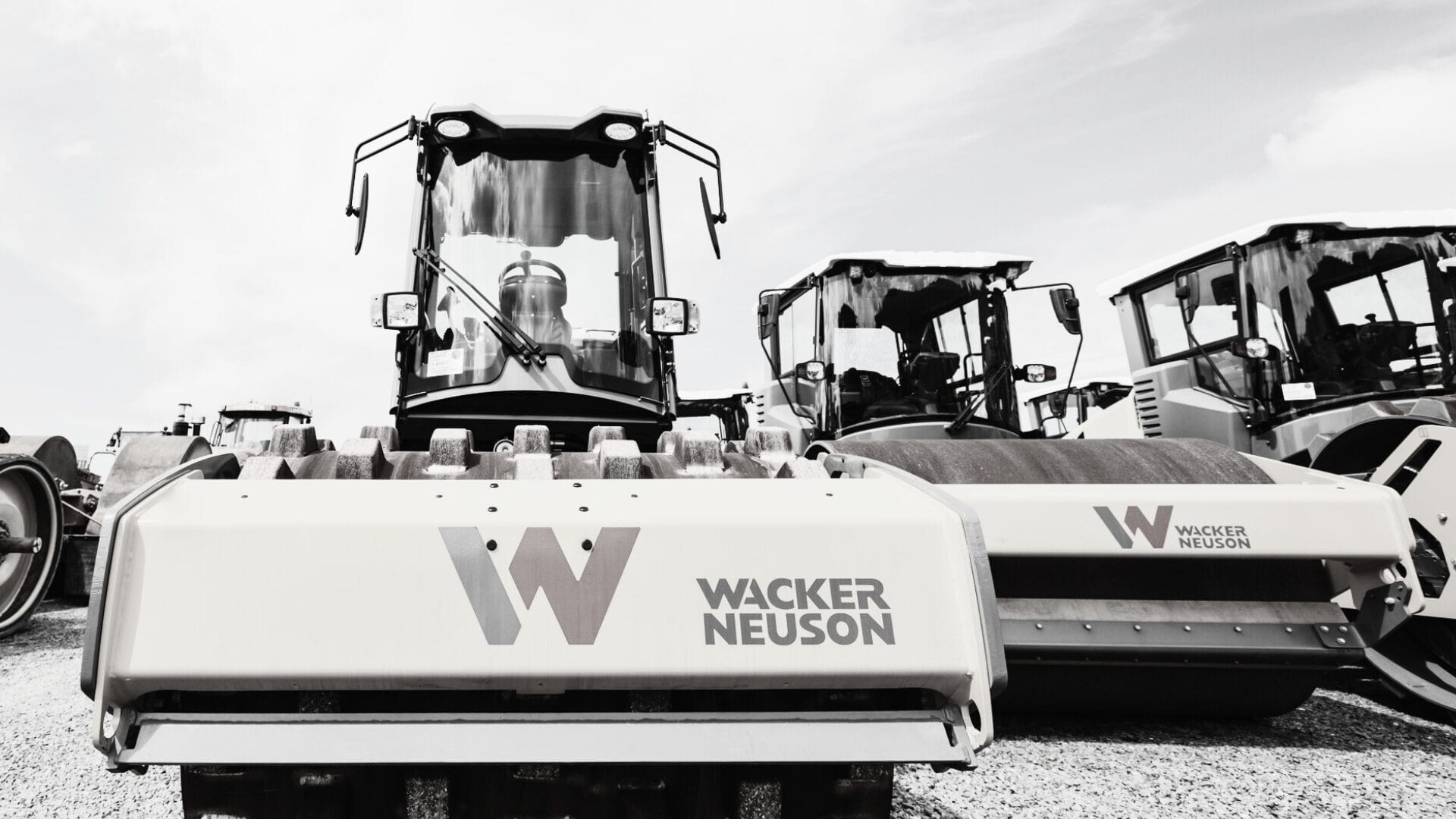How compaction varies by region in Australia.
We’ve run the numbers. As it turns out – *drum roll* – Australia’s pretty big.
In a construction context, what that means is a lot of variation in site conditions. With climates ranging from the tropical north to the temperate south, and soil types as diverse as clay, sand, and rocky terrains, there are countless variables to contend with. All of these factors have a bearing on what compaction roller you choose, and how you use it.
The sheer scale of the country means there’s no one-size-fits-all solution when it comes to soil compaction. The vast and varied landscape creates unique challenges for what might be considered ‘best practice’.
So, what are the key differences in soils, topography, and climate across Australia? And how can you solve for these factors in your approach to soil compaction to ensure the best results?
Contents:
Factors influencing soil compaction in different regions
Key differences in Australian soil types
Do environmental changes play a part?
How to accurately assess soil conditions on site
Factors influencing soil compaction in different regions
- Soil type
There are several soil types present in Australia – the most prevalent being sand, clay, and rocky – all of which have different drainage properties, density, and stability. - Moisture level
Moisture content is a key factor in soil compaction. Different soil types require different moisture levels to achieve optimum density. The most reliable way to assess the moisture content of soil is via the Standard Proctor Test and Modified Proctor Test. Learn more about these testing processes. - Climate
Australia’s climate delivers harsh extremes. Scorching summers and frosty winters, with drought and flooding often occurring simultaneously in different regions. When moisture levels can drastically affect compaction, being able to navigate these changing conditions – not only during construction, but also ensuring the long-term stability of structures – can pose a monumental challenge. - Topography
Australia’s varied topography, from flat plains to mountainous regions, requires different compaction roller equipment and methods. Naturally, if a site is part of an undulating or uneven landscape, it will require some amount of excavation, filling, and rolling to make it flat or suitably tiered to accommodate planned structures.
There are all kinds of specific requirements for fills depending on whether a site is sloping or flat, what structure is being supported, and what material is involved. Learn more about preparation requirements for foundations and footings. - Land use
Previous use of a building site may contribute to its suitability or readiness for construction. Agricultural, urban, and industrial land uses necessitate different compaction approaches. For example, redevelopment of a site that’s already been used for similar structures, means it’s likely that the site’s subgrades are already pretty solid compared to land that’s never been built on.
Of course, any loose top layers that have been dug up and filled will still require compaction. However, the requirements of fill material (and how it’s compacted) will vary based on its use. This includes terminology like ‘controlled fill’, ‘rolled fill’, as well as engineered, structural, or granular fill.
Controlled fill refers to material that’s placed and compacted in layers with compaction equipment (e.g. vibrating plate) within a defined moisture range to a defined density requirement.
Rolled fill refers to material placed in layers and compacted with repeated passes by a heavy roller.
Key differences in Australian soil types
In terms of Australian soil classification, there are technically 15 distinct soil orders in Australia. Things don’t tend to get quite that granular (pun intended) for the sake of construction purposes. But there are still certain compounds and properties to consider when testing soil and preparing for construction.
Understanding these unique soil types is crucial for effective compaction.
- Clay-Based Soils
Typically found in regions like Victoria and parts of New South Wales. Clay-based soils have very small particles that retain water and can become very dense. In dry conditions, it can bake and crack. Generally firm and stable.
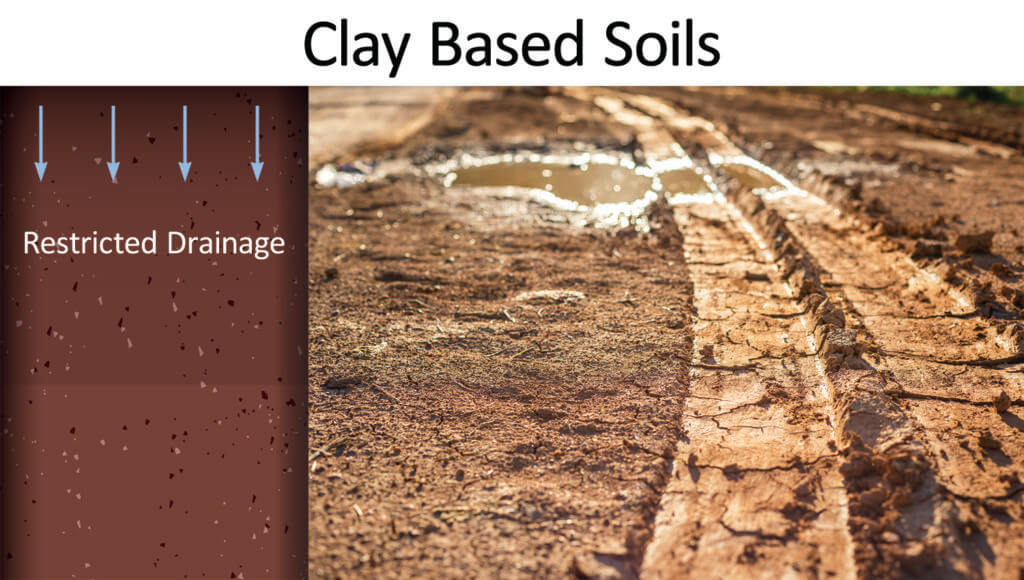
- Sand-Based Soils
Common in coastal areas such as Queensland and Western Australia. Sandy soils drain well due to their loose structure. But this same property can make them prone to slumping, settling, and erosion. Soils with high sand content require specific compaction techniques, involving the use of water and vibratory rollers to allow shifting particles to settle and stabilise prior to construction.
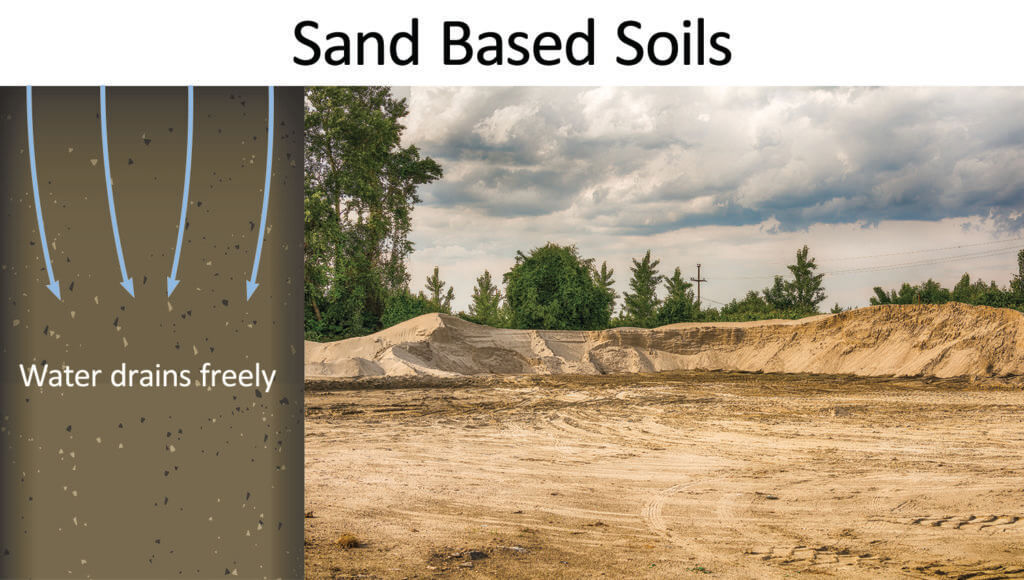
- Rocky Soils
Found in areas like South Australia and parts of Tasmania. Rocky soils can have inconsistent density and cause impediments, requiring larger rollers (over 20t) for effective compaction.
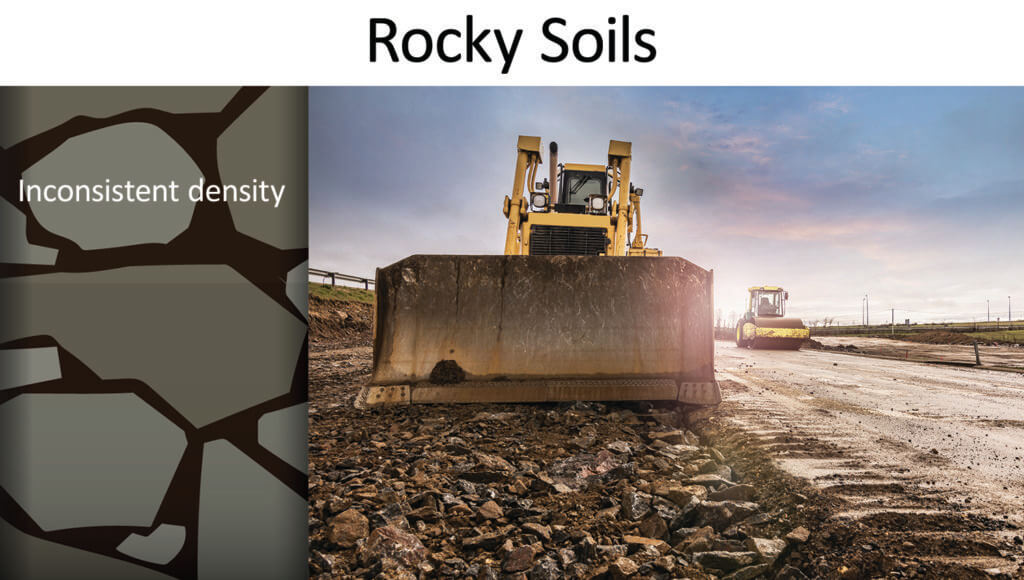
- Mixed soils
While certain soil types vary by region, their characteristics aren’t always clearly delineated. Mixed soil can often be found on sites, containing a combination of cohesive and granular particles. This can also be the case when additional soil is imported for fills and combines with existing material. Mixed soils are good for compaction because smaller particles can shift into the spaces between the larger particles, providing a firm base for construction.
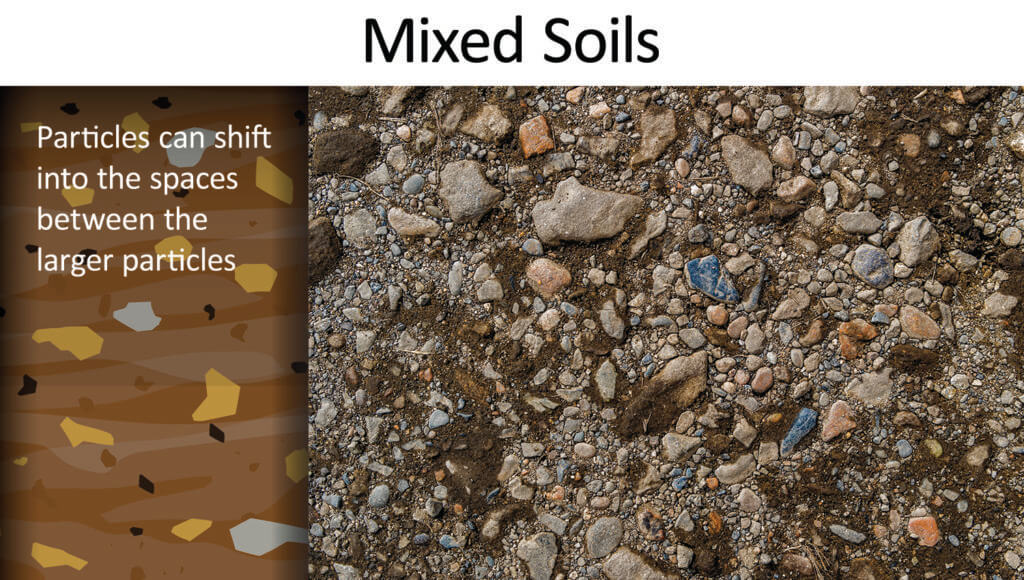
- Moisture Variability
Of course, moisture levels are very much seasonal and not always consistent. The Northern Territory and northern Queensland have higher moisture levels due to tropical climates, impacting compaction efforts. Coastal regions in general will tend to have higher moisture, especially in the eastern states. Not only can heavy rain cause construction delays due to onsite flooding, but it can dictate the overall compaction approach, along with drainage considerations.
Do environmental changes play a part?
The construction sector is always vulnerable to volatile weather conditions. And Australia’s climate is certainly prone to extremes – generally bouncing between periods of drought and heavy rain, though not always in predictable cycles.
Recent years have seen an increase in delays due to heavy rainfall and flooding. In fact, weather reportedly had an even bigger impact on construction delays than COVID, with 40% of working days lost to wet weather alone in 2021-22.
While delays and ensuing cost pressures are top of mind for project managers, it’s not the only concern stemming from climate. Key considerations also include:
- Ecosystem Protection: Ensuring compaction does not harm increasingly fragile local ecosystems, particularly in reforestation areas.
- Reforestation Efforts: Balancing soil stability with tree planting.
- Worker Safety: Aside from site conditions themselves, there are also regulations regarding ‘Inclement Weather’ that prohibit building or civil construction workers from working in certain conditions due to safety considerations.
As much as environmental changes impact construction practices, it’s also the responsibility of new developments to minimise the impact to the site’s surrounding environment, including ecosystems, natural habitats, or pre-existing infrastructure. Thorough planning and site assessment is required so as not to alter waterways and underground springs and channels, or potentially cause pipework damage.
Compaction best practice by state
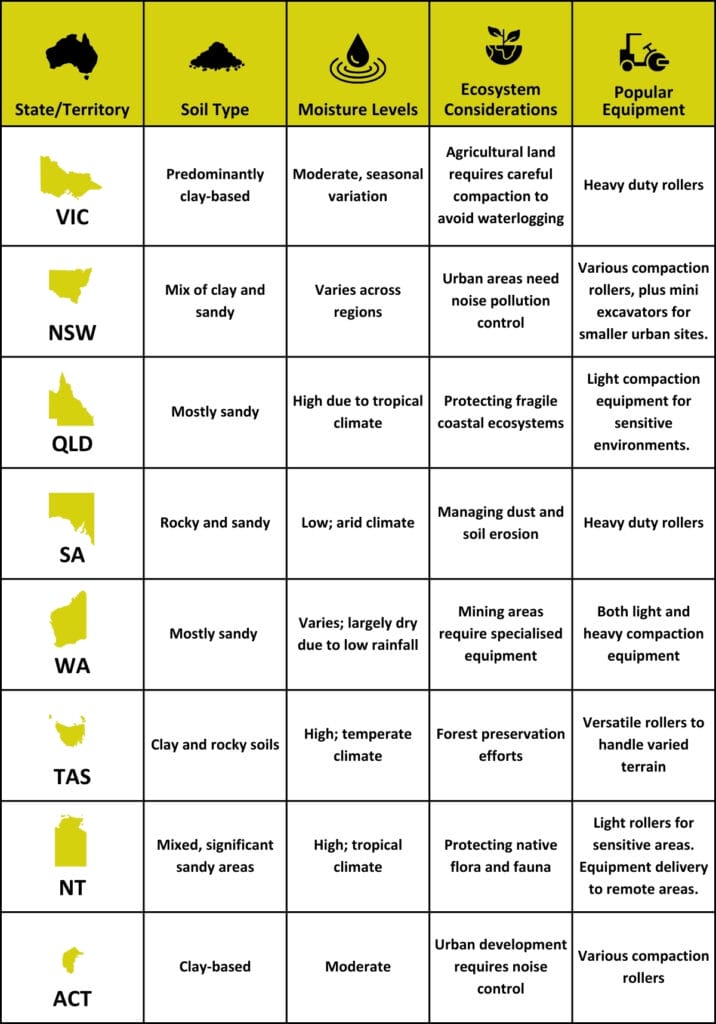
Looking for compaction equipment? Check out our hire range.
Frequently Asked Questions
The main factors include soil type, moisture content, compaction effort, and the type of compaction equipment used. Different soils respond differently to compaction efforts, and moisture levels can significantly impact the process.
Clay soils are generally more prone to compaction due to their fine particles and ability to retain water. Sandy soils, while less prone to compaction, require specific techniques to achieve optimal compaction.
Summary
Construction and project managers will know that every job is assessed on a project-by-project, site-by-site basis. Even when working to similar specs, there’s no accounting for the precise variables that will crop up as a project gets underway. Every solution must be tailored to the specific site conditions, underpinned by thorough preparation, testing, and the ability to adapt.
Whether dealing with the dense clay soils of Victoria, the rocky surfaces of South Australia, the sandy terrains of Queensland and beyond, selecting the right equipment and techniques is essential for efficient and sustainable construction.
Conplant delivers all equipment direct to site, with a full tank of petrol, anywhere in Australia. Want to chat about the most effective equipment fleet for your next project? Get in touch today.



